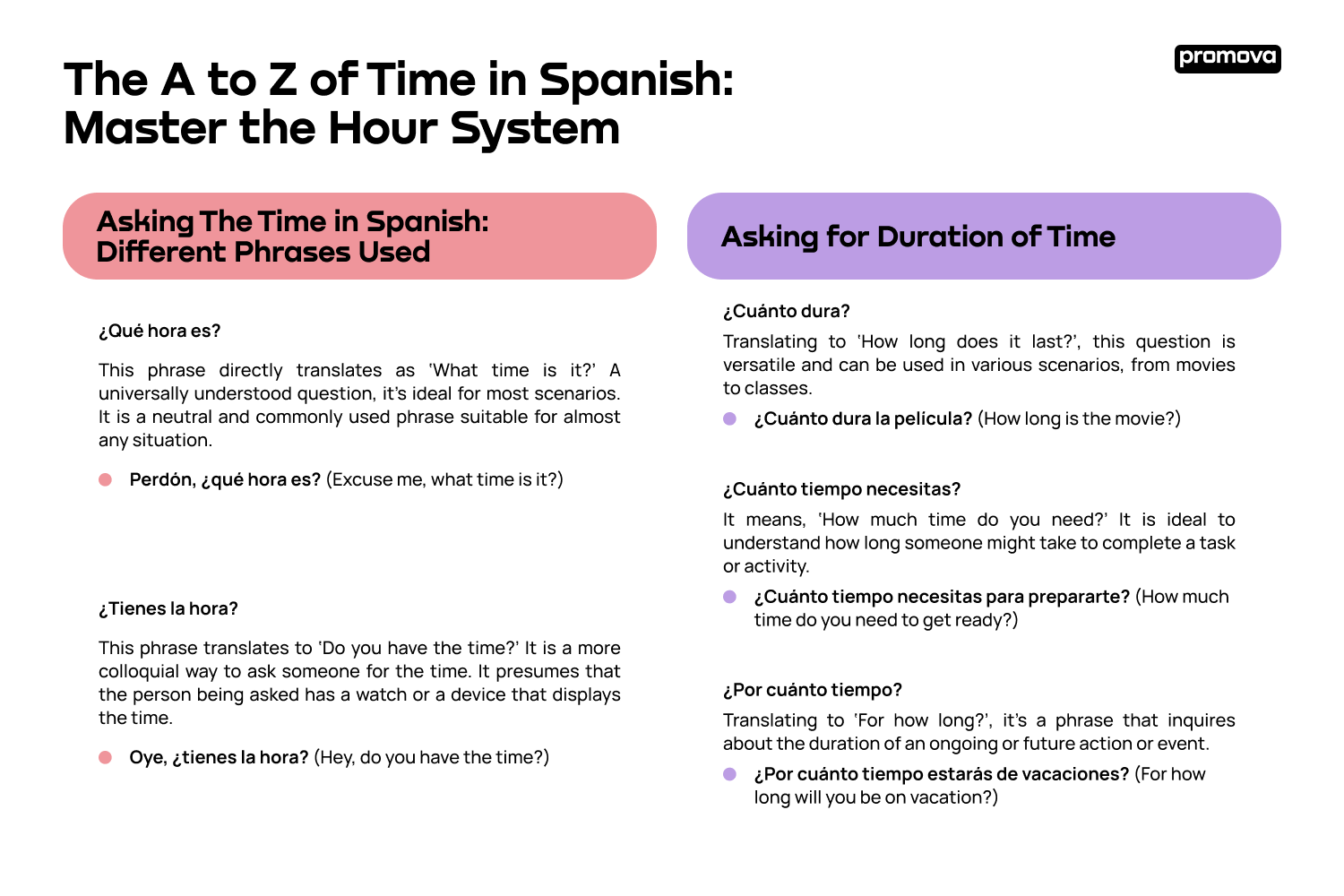The A to Z of Time in Spanish: Master the Hour System

Contents
Time is a universal concept, but how we articulate it can vary dramatically between languages. The Spanish language offers its unique approach to discussing it. Telling time in Spanish is more than just reading numbers; it’s about mastering the hour system with its specific nuances. This guide offers a comprehensive breakdown of that system, starting from the very basics. We will provide various Spanish phrases, expressions, and special vocabulary critical for time-telling.
Understanding the Basics of The Spanish Hour System
While not drastically different from many other languages, the Spanish hour system contains nuances that can perplex learners. Delving into its structure is key for anyone aiming to communicate effectively in Spanish.
At its core, Spanish utilizes a 24-hour clock for formal scenarios, which is especially prevalent in timetables and official schedules. Yet, in everyday conversation, the 12-hour system reigns supreme, echoing the familiarity of its English counterpart. However, instead of the ‘a.m.’ and ‘p.m.’ delineations, Spanish adopts evocative terms: ‘de la mañana’ for the morning hours, ‘de la tarde’ post noon, and ‘de la noche’ as dusk gives way to night.
In addition to the time in Spanish 24-hour clock, it’s essential to grasp the verb ‘ser,’ used when telling the time. The phrases ‘Es la una’ and ‘Son las dos’ translate to ‘It is one o’clock’ and ‘It is two o’clock’ respectively, demonstrating the change in verb form depending on the hour.
Asking The Time in Spanish: Different Phrases Used
When navigating the streets of Spain or conversing with a Spanish-speaking friend, one of the most fundamental questions revolves around time. Spanish offers several ways to inquire about the hour, each fitting various contexts and degrees of formality. Below, you’ll find some commonly used phrases:
- ¿Qué hora es?
This phrase directly translates as ‘What time is it?’. A universally understood question, it’s ideal for most scenarios. It is a neutral and commonly used phrase suitable for almost any situation.
Perdón, ¿qué hora es? (Excuse me, what time is it?)
- ¿Tienes la hora?
This phrase translates to ‘Do you have the time?’ It is a more colloquial way to ask someone for the time. It presumes that the person being asked has a watch or a device that displays the time.
Oye, ¿tienes la hora? (Hey, do you have the time?)
- ¿Sabes qué hora es?
Translating to ‘Do you know what time it is?’, it is a softer, more indirect way to inquire about the time.
¿Sabes qué hora es? (Do you know what time it is?)
How to Tell Time in Spanish: Using Numbers and Terms
Telling time chiefly relies on correctly using numbers and terminologies. This section provides essential vocabulary and phrases that help to tell the hour accurately.
Basics of Counting Hours in Spanish
When indicating a specific hour in Spanish, you’ll mostly rely on the verb ‘ser’ in its two forms: ‘es’ and ‘son.’ For one o’clock, use ‘es.’ For all other times, use ‘son.’ Here’s how to say time in Spanish:
- Es la una en punto – It’s one o’clock.
- Son las dos en punto – It’s two o’clock.
- Son las tres en punto – It’s three o’clock.
- Son las cuatro en punto – It’s four o’clock.
- Son las cinco en punto – It’s five o’clock.
- Son las seis en punto – It’s six o’clock.
- Son las siete en punto – It’s seven o’clock.
- Son las ocho en punto – It’s eight o’clock.
- Son las nueve en punto – It’s nine o’clock.
- Son las diez en punto – It’s ten o’clock.
- Son las once en punto – It’s eleven o’clock.
- Son las doce en punto – It’s twelve o’clock.
It’s crucial to note the plural ‘las’ used from two onwards, denoting the multiple hours that have passed since midnight or noon.
Expressions for Half Past, Quarter Past, Quarter To
When describing clock times in Spanish, we use expressions to denote quarters and halves. Let’s delve into the phrases and examples used in such contexts:
- Y media – Half past
Son las cuatro y media. (It’s four-thirty.)
- Y cuarto – Quarter Past
Son las cinco y cuarto (It’s five-fifteen.)
- Menos cuarto – Quarter To
Son las seis menos cuarto. (It’s a quarter to six.)
The phrase ‘menos cuarto’ may seem a bit confusing at first. Translated, it means ‘minus a quarter.’ In practice, it indicates fifteen minutes left until the next hour – similar to saying ‘quarter to six’ in English.
14
Saying Specific Minutes
When stating exact minutes in Spanish, it’s essential to understand the structure and the terminology. The language follows a simple ‘hours + y + minutes’ format up to the half-hour mark, after which it subtracts minutes from the next hour. This system might sound intricate initially, but it becomes intuitive with practice.
- Adding Minutes Post Hour (Up to Half-Hour). The word ‘y’ (meaning ‘and’) is used to add minutes to a given hour.
Son las tres y cinco. (It’s five past three.)
Son las cuatro y diez. (It’s ten past four.)
- Subtracting Minutes from the Next Hour (After Half-Hour). Post the half-hour mark, rather than counting up from the current hour, you’ll count down to the next hour using ‘menos.’
Son las ocho menos veinte. (It’s twenty to eight.)
Son las once menos diez. (It’s ten to eleven.)
- For The Sake of Clarity. If you wish to specify whether it’s morning, afternoon, or night, you can add ‘de la mañana,’ ‘de la tarde,’ or ‘de la noche,’ respectively.
Son las seis y veinte de la mañana. (It’s twenty past six in the morning.)
Son las siete menos cuarto de la tarde. (It’s a quarter to seven in the evening.)
Asking for Duration of Time
Understanding how to express the length or duration of an event, activity, or experience is crucial when navigating the world of Spanish. It’s not just about asking the current time; it’s equally vital to know how long something lasts or how much time one needs for a particular task. Here, we delve into the commonly used phrases and expressions to ask for and provide information about durations.
- ¿Cuánto dura?
Translating to ‘How long does it last?’, this question is versatile and can be used in various scenarios, from movies to classes.
¿Cuánto dura la película? (How long is the movie?)
- ¿Cuánto tiempo necesitas?
It means, ‘How much time do you need?’ It is ideal to understand how long someone might take to complete a task or activity.
¿Cuánto tiempo necesitas para prepararte? (How much time do you need to get ready?)
- ¿Por cuánto tiempo?
Translating to ‘For how long?’, it’s a phrase that inquires about the duration of an ongoing or future action or event.
¿Por cuánto tiempo estarás de vacaciones? (For how long will you be on vacation?)
- Durará aproximadamente...
When giving an estimate of the duration, this phrase is used. It translates to ‘It will last approximately...’
El viaje durará aproximadamente seis horas. (The trip will last approximately six hours.)

Time-Related Adverbs: Now, Later, Tomorrow, and Others
Navigating the temporal landscape of Spanish requires more than just understanding numbers and how to read the clock. Time-related adverbs are essential linguistic tools, offering context, sequence, and specificity to our interactions. Let’s delve into some of the most commonly used time-related adverbs in Spanish.
- Ahora – Now.
- Más tarde – Later.
- Mañana – Tomorrow.
- Pasado mañana – The day after tomorrow.
- Ayer – Yesterday.
- Anteayer or Antier – The day before yesterday.
- Hoy – Today.
- Siempre – Always.
- Nunca – Never.
- Pronto – Soon.
- A veces – Sometimes.
- Tarde – Late.
- Temprano – Early.
Understanding and correctly utilizing these adverbs enhances the depth of conversation in Spanish. They offer a clearer frame of reference, allowing for better comprehension and engagement.
Additional Vocabulary Related To Spanish Clock Times
To achieve fluency in discussing time, it’s beneficial to familiarize oneself with a broader vocabulary and expressions. Beyond the basic numbers and periods, these terms give depth and detail to time-related conversations:
- Mediodía – Noon/Midday.
- Medianoche – Midnight.
- A tiempo – On time.
- Tarde – Late.
- Temprano – Early.
- Minuto – Minute.
- Segundo – Second.
- Hora punta/Hora pico – Rush hour.
- Reloj – Clock or watch.
- Despertador – Alarm clock.
- En punto – On the dot/sharp.
- Duración – Duration.
Incorporating these words and expressions into your vocabulary enhances your ability to discuss, plan, and understand events and schedules in Spanish. Whether navigating a bustling city’s rush hour or setting an alarm for an early start, this vocabulary equips you for a broad range of time-centric scenarios.
Unlock Your Language Potential with Promova
Promova is the ultimate one-stop solution for language learning. Whether English, Korean, Spanish, or French is on your radar, the platform ensures you’ll get the resources needed to communicate confidently in a foreign language.
With our guided courses on both the Promova app and website, you gain access to essential vocabulary lists, comprehensive grammar rules, and interactive quizzes where you can continually assess your progress. The best part is that everything happens at your pace, making Promova perfect for every learner.
If you aim for English proficiency, we provide real-time practice tools such as group classes and personalized 1x1 sessions conducted by seasoned tutors. You can directly immerse yourself in real conversation scenarios while receiving feedback from professionals. And when signing up with us, you get a free personal lesson!
Conclusion
Understanding the nuances of telling time in Spanish opens up more refined conversations and navigation through various scenarios in Spanish-speaking environments. From mastering ‘ser’ in its appropriate forms to employing adverbs for a richer contextual frame, every detail contributes to a comprehensive grasp of the Spanish time-telling system. Furthermore, knowing how to write time in Spanish and getting acquainted with specific expressions and vocabulary can offer more depth and accuracy in your conversations.
FAQ
Are there regional variations in Spanish-speaking countries when it comes to telling time?
Yes, Spanish, like other languages, has its regional nuances. For example, while Spain predominantly follows the 24-hour system in formal contexts, many Latin American countries might lean more towards the 12-hour system even in official documents. Additionally, some expressions used to say time in Spanish might vary. It’s always a good idea to familiarize oneself with regional specifics when planning to visit or communicate with people from a particular area.
How does the Spanish handle daylight saving time?
Daylight saving time (DST) is recognized in many Spanish-speaking regions, including Spain. People adjust their clocks accordingly and might refer to it as ‘horario de verano’ (summer time) or ‘horario de invierno’ (winter time).
How do Spanish-speaking cultures view punctuality?
Cultural attitudes towards punctuality can vary across Spanish-speaking countries. Generally, in business settings, punctuality is highly valued. However, it might be more flexible in social settings, especially in Latin American countries, with people sometimes arriving 10-30 minutes after the agreed time. It’s essential to be aware of these cultural nuances and adapt accordingly.
What are some tools to help better understand Spanish time-related terms?
For mastering time in Spanish and other vocabulary, consider dictionaries like WordReference and Cambridge English-Spanish Dictionary. These offer bilingual definitions and examples, along with pronunciation aids. Also, the Promova Spanish language learning app will be a valuable tool where you can learn, practice, and reinforce vocabulary.
Comments